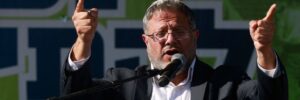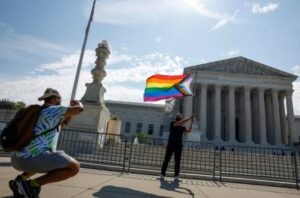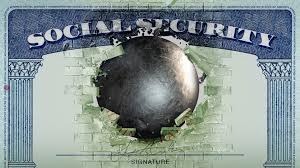THE THANKSGIVING myth is intertwined with this country’s origin myth.
Puritans fleeing religious persecution in England landed on Plymouth Rock in 1620 in search of freedom. Indians helped them plant corn and survive. They made a compact that is the basis of our first constitution, and they held a feast, together with some Indians, to celebrate and give thanks to God for their first bounteous harvest.
The story has elements of truth, but not much more than elements. What children learn is the overarching message–that Pilgrims were everything good about America: European, Christian, sober, democratic, generous, God-fearing, and so on and so forth.
True, an Indian named Squanto did teach the Pilgrims how to plant corn and saved the invaders from total starvation. What we aren’t told is that Squanto learned English because he had been abducted and made a slave in Europe some years before, and the place where he taught the new settlers to plant corn was the village he had grown up in, Patuxet, now depopulated by the impact of European diseases.
The colonists planted their first crops in an abandoned field cleared by Indians, and found the area strewn with the bleached bones of dead Indians, which the surviving ones, having fled elsewhere, were unable to bury.
There are other problems with the story. The Pilgrims’ relations with the first Indians they encountered were not initially friendly; short of provisions, the Pilgrims stole corn from a granary of the Nauset Indians, and later robbed a grave and some Indian houses they stumbled across.
What has in hindsight been described as the “first” Thanksgiving was a typical English harvest feast. It took place almost a year into the existence of the settlement, whose numbers had dwindled by half because of disease and starvation to only 50 people. According to the account of William Bradford, 90 Indians, led by Massassoit, the Wampanoag chief or Sachem, attended the feast, bringing five deer with them.
In all the Thanksgiving stories and plays, the Indians are really a kind of sideshow to the Pilgrim “fathers”–even though all the foods were Indian foods; the Indians outnumbered the Pilgrims; and without the Indians, the Pilgrims would not have survived. Yet the thanks are never to the Indians, but to God, to the Pilgrims themselves–anything but to Native Americans.
THIS IMAGE of Indians as props for the occasion still persists. It reflects a not uncommon view of the “New World,” peddled from the beginning by Europeans who aimed to conquer and settle it–that it was a sparsely populated place, inhabited by nomadic people.
Capt. John Smith, who had helped settle Jamestown in 1609, argued that Englishmen could rightfully seize Indian land because God intended land to be cultivated, and this land was “unmanned wild country” that Indians “range rather than inhabit.” (Did the Zionist leaders who founded Israel read Smith?)
The truth was very different. On the Eastern seaboard, Indians did “tame” the land. They grew three types of corn, with at least two growing seasons, as well as squash and beans, and they supplemented their diet with fish, shellfish, deer and birds. They cleared land not only for farming, but also set controlled brush fires in forests in order to create better hunting conditions. They made extensive systems of trails and roads for trade and travel, and more. The English settlers found wooded areas that looked like parks and large open fields that reminded them of home.
In New England, what may have been bubonic plague, brought to coastal Maine a few years before the arrival of the Mayflower, had reduced Massasoit’s Pokanokets from 12,000 people, with 3,000 warriors, to a tribe able to deploy only a few hundred fighters. Indeed, the reason Massasoit was so friendly to the Pilgrims was because he felt too weak to fend off his rivals, the larger Naragansetts, and hoped to form an alliance with the newcomers to strengthen his position.
The myth also obscures the purpose of the colony. While it was true that some of the Mayflower passengers were English Puritans attempting to find a place to practice their religion without persecution, more than half of the colonists were not Puritans. Moreover, in order to be able to travel to this “New World,” the colonists had to secure the backing of a joint-stock company whose investors expected a return on their investment.
Plymouth was both a profit-making venture and an outpost of English imperialism. There had been a spate of colonizing efforts by England in the region, in competition with other European powers Spain, France and Holland. England, like its competitors, aimed to claim this “New World” and its riches by any means necessary, including the outright extermination of entire peoples.
The historian Francis Jennings outlines the policy adopted by English conquerors that had already been established in Ireland:
(1) A deliberate policy of inciting competition between natives in order, by division, to maintain control; (2) a disregard for pledges and promises to natives, no matter how solemnly made; (3) the introduction of total exterminatory war against some communities of natives in order to terrorize others; and (4) a highly developed propaganda of falsification to justify all acts and policies of the conquerors whatsoever.
Listen to this Jamestown colonist, writing after the Powhatans had risen to drive out the English settlers in 1622:
We, who hitherto have had possession of no more ground then their waste, and our purchase…may now by right of War, and law of Nations, invade the Country, and destroy them who sought to destroy us: whereby we shall enjoy their cultivated places…and possessing the fruits of others labors. Now their cleared grounds in all their villages (which are situated in the fruitfulest places of the land) shall be inhabited by us.
The Indians were not prepared for the level of savagery meted out against them.
In 1621, the Plymouth colonies’ military commander, Captain Miles Standish, ambushed and massacred a group of eight Massachusetts Indians north of Plymouth in order to set an example to those who might consider challenging the Plymouth settlement. “This sudden and unexpected execution,” wrote colonist Edward Winslow, “hath so terrified and amazed them…they forsook their houses…living in swamps…and so brought manifold diseases amongst themselves, whereof very many are dead.”
After this incident, the invaders acquired a new name among the indigenous people: “Wotowquenange,” meaning stabbers or cutthroats.
IT SHOULD be clear, then, that the first Thanksgiving was not the end of the story. The Indians very quickly discovered they had little to celebrate.
As the European settlements grew and began to outnumber the Indians, the invaders became more arrogant, more land-hungry and more powerful. The increasing encroachment on Indian lands built to a tension that eventually provoked some Indians into decisive and desperate action.
Some 64 years after the colonists feasted with Massassoit, in 1675, Massasoit’s son, Metacomet, known by the Pilgrims as “King Philip,” fought a war of resistance against the New England colonists. At the war’s end, 600 were killed and 1,200 houses burned in the English side; 3,000 Indians were killed, many of them victims of outright massacres by the colonists. Survivors were sold into slavery.
Philip was finally hunted down and eventually murdered. The colonists displayed Philip’s head on a pole in Plymouth, where it remained for 25 years.
This story of conquest and resistance is not part of the “Thanksgiving” myth because the myth is meant to sanitize history and make the invasion of the Americas by European conquerors a benign and sublime national origin story.
Indeed, in 1970, the Massachusetts Department of Commerce asked the Wampanoags to select a speaker to mark the 350th anniversary of the Pilgrims’ landing. Before Wamsutta Frank James could read his speech, though, it had to be approved by the people in charge of the ceremony. Here is what they decided not to allow him to read:
Today is a time of celebrating for you…but it is not a time of celebrating for me. It is with heavy heart that I look back upon what happened to my people…The Pilgrims had hardly explored the shores of Cape Cod four days before they had robbed the graves of my ancestors and stolen their corn…
Massassoit, the great leader of the Wampanoag, knew these facts; yet he and his people welcomed and befriended the settlers…[B]efore 50 years were to pass, the Wampanoags…and other Indians living near the settlers would be killed by their guns or dead from diseases that we caught from them…Although our way of life is almost gone and our language is almost extinct, we the Wampanoags still walk the lands of Massachusetts…
What has happened cannot change, but today we work toward a better America, a more Indian America where people and nature are once again more important.
In response to the censorship, a group calling itself the United American Indians of New England declared the Thanksgiving holiday to be a National Day of Mourning.
On that day in 1970, protesters boarded the Mayflower II (a replica of the Pilgrims’ original ship, built in 1957) and tore the Union Jack from the mast. It was replaced with the flag that had flown the year before over liberated Alcatraz Island when Indian activists in California had occupied it, and offered to buy Alcatraz from the government for $24, the same price the Dutch paid for Manhattan.
THE UNITED American Indians of New England have held a Day of Mourning every year since in Plymouth.
Thirty-two years later, at the Day of Mourning in 2001, Moonanum James drew the connection between the resistance of Native Americans in the past and the struggles they face today:
Back in 1970, those who started Day of Mourning spoke of terrible racism and poverty.
Racism is still alive and well. Our people still are mired in the deepest poverty. We still lack decent health care, education and housing. Every winter, thousands of our people have to make a bitter choice between heating and eating. Our youth suicide rates, our rates of alcoholism continue to be the highest in the nation. As the economy crumbles around us, these conditions will only worsen.
Today, we mourn the loss of millions of our ancestors and the devastation of our beautiful land and water and air. We pray for our people who have died during this past year. We join America in grieving for those who lost their lives at the World Trade Center.
And I hope that you will join me in grieving, too, for the immense suffering of our sisters and brothers in Afghanistan, in Palestine, in Iraq–human beings who are referred to by this government as “collateral damage.” We remember all too well that our people throughout the Americas have for centuries been the “collateral damage” of the European invasion.
The events of this past September were tragic and have affected all of us. Many innocent people lost their lives. We condemn all acts of violence and terrorism perpetrated by all governments and organizations against innocent civilians worldwide. And we condemn the racial profiling and detentions that are being directed against our Arab, South Asian and Muslim brothers and sisters in this country.
But the events of September 11 were certainly not the first acts of terrorism to have occurred in this country. Since Columbus and the rest of the Europeans invaded our lands, Native people have been virtually nonstop victims of terrorism. I think of the slaughter of the Pequots at Mystic, Connecticut, in 1637. I think of U.S. military massacres of peaceful Native people at Wounded Knee and Sand Creek, and so many, many other places. I think of the armed assault by the FBI on a peaceful encampment at Pine Ridge in the 1970s.
In fact, the very foundations of this powerful and wealthy country are the theft of our lands and slaughter of Native peoples and the kidnapping and enslavement of our African-American sisters and brothers. And the U.S.-assisted terrorism against Native peoples continues to this day in all too many countries in Central and South America…
These are indeed difficult times. But our ancestors and our traditions will give us the strength that we need. Always we must remember that we shall endure. A handful of us somehow managed to survive Columbus and the conquistadors and the Pilgrims and the French and all the other invaders.
Beautiful Native youth: Remember what your ancestors went through to bring you here. We are like the dirt, like the sand, like the tides. We shall endure. The struggle will continue. In the spirit of Crazy Horse, in the spirit of Zapata, in the spirit of Metacom, in the spirit of Anna Mae Aquash, in the spirit of Geronimo: We are not vanishing. We are not conquered. We are as strong as ever.
Paul D'Amato is the author of The Meaning of Marxism and was the editor of the International Socialist Review. He is the author of numerous articles on a wide array of topics.




